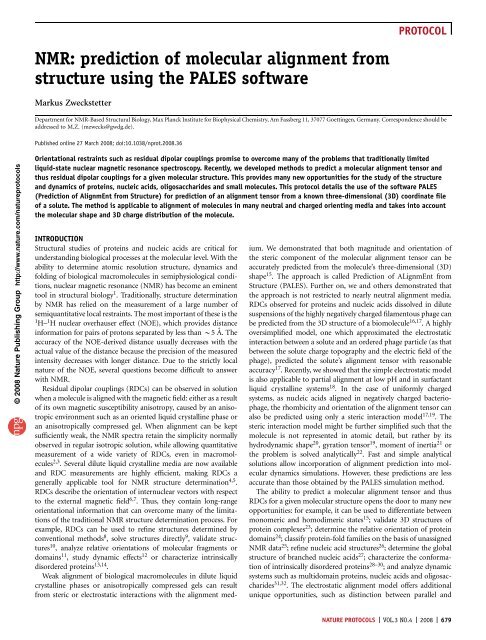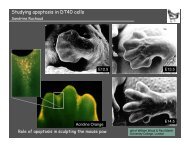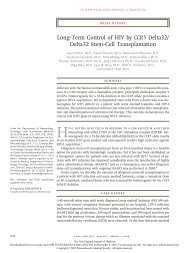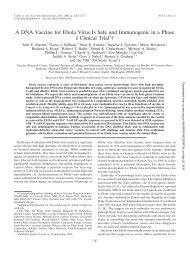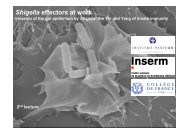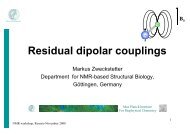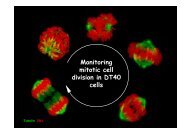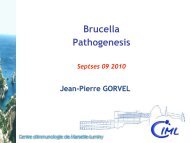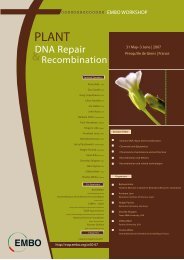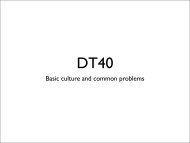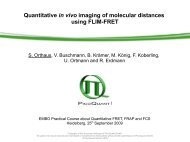b) NMR: prediction of molecular alignment from structure
b) NMR: prediction of molecular alignment from structure
b) NMR: prediction of molecular alignment from structure
Create successful ePaper yourself
Turn your PDF publications into a flip-book with our unique Google optimized e-Paper software.
© 2008<br />
Nature<br />
Publishing<br />
Group<br />
http:<br />
/ / www.<br />
nature.<br />
com/<br />
natureprotocols<br />
<strong>NMR</strong>: <strong>prediction</strong> <strong>of</strong> <strong>molecular</strong> <strong>alignment</strong> <strong>from</strong><br />
<strong>structure</strong> using the PALES s<strong>of</strong>tware<br />
Markus Zweckstetter<br />
Department for <strong>NMR</strong>-Based Structural Biology, Max Planck Institute for Biophysical Chemistry, Am Fassberg 11, 37077 Goettingen, Germany. Correspondence should be<br />
addressed to M.Z. (mzwecks@gwdg.de).<br />
Published online 27 March 2008; doi:10.1038/nprot.2008.36<br />
Orientational restraints such as residual dipolar couplings promise to overcome many <strong>of</strong> the problems that traditionally limited<br />
liquid-state nuclear magnetic resonance spectroscopy. Recently, we developed methods to predict a <strong>molecular</strong> <strong>alignment</strong> tensor and<br />
thus residual dipolar couplings for a given <strong>molecular</strong> <strong>structure</strong>. This provides many new opportunities for the study <strong>of</strong> the <strong>structure</strong><br />
and dynamics <strong>of</strong> proteins, nucleic acids, oligosaccharides and small molecules. This protocol details the use <strong>of</strong> the s<strong>of</strong>tware PALES<br />
(Prediction <strong>of</strong> AlignmEnt <strong>from</strong> Structure) for <strong>prediction</strong> <strong>of</strong> an <strong>alignment</strong> tensor <strong>from</strong> a known three-dimensional (3D) coordinate file<br />
<strong>of</strong> a solute. The method is applicable to <strong>alignment</strong> <strong>of</strong> molecules in many neutral and charged orienting media and takes into account<br />
the <strong>molecular</strong> shape and 3D charge distribution <strong>of</strong> the molecule.<br />
INTRODUCTION<br />
Structural studies <strong>of</strong> proteins and nucleic acids are critical for<br />
understanding biological processes at the <strong>molecular</strong> level. With the<br />
ability to determine atomic resolution <strong>structure</strong>, dynamics and<br />
folding <strong>of</strong> biological macromolecules in semiphysiological conditions,<br />
nuclear magnetic resonance (<strong>NMR</strong>) has become an eminent<br />
tool in structural biology 1 . Traditionally, <strong>structure</strong> determination<br />
by <strong>NMR</strong> has relied on the measurement <strong>of</strong> a large number <strong>of</strong><br />
semiquantitative local restraints. The most important <strong>of</strong> these is the<br />
1 H– 1 H nuclear overhauser effect (NOE), which provides distance<br />
information for pairs <strong>of</strong> protons separated by less than B5 A ˚ .The<br />
accuracy <strong>of</strong> the NOE-derived distance usually decreases with the<br />
actual value <strong>of</strong> the distance because the precision <strong>of</strong> the measured<br />
intensity decreases with longer distance. Due to the strictly local<br />
nature <strong>of</strong> the NOE, several questions become difficult to answer<br />
with <strong>NMR</strong>.<br />
Residual dipolar couplings (RDCs) can be observed in solution<br />
when a molecule is aligned with the magnetic field: either as a result<br />
<strong>of</strong> its own magnetic susceptibility anisotropy, caused by an anisotropic<br />
environment such as an oriented liquid crystalline phase or<br />
an anisotropically compressed gel. When <strong>alignment</strong> can be kept<br />
sufficiently weak, the <strong>NMR</strong> spectra retain the simplicity normally<br />
observed in regular isotropic solution, while allowing quantitative<br />
measurement <strong>of</strong> a wide variety <strong>of</strong> RDCs, even in macromolecules<br />
2,3 . Several dilute liquid crystalline media are now available<br />
and RDC measurements are highly efficient, making RDCs a<br />
generally applicable tool for <strong>NMR</strong> <strong>structure</strong> determination 4,5 .<br />
RDCs describe the orientation <strong>of</strong> internuclear vectors with respect<br />
to the external magnetic field 6,7 . Thus, they contain long-range<br />
orientational information that can overcome many <strong>of</strong> the limitations<br />
<strong>of</strong> the traditional <strong>NMR</strong> <strong>structure</strong> determination process. For<br />
example, RDCs can be used to refine <strong>structure</strong>s determined by<br />
conventional methods 8 , solve <strong>structure</strong>s directly 9 ,validate<strong>structure</strong>s<br />
10 , analyze relative orientations <strong>of</strong> <strong>molecular</strong> fragments or<br />
domains 11 , study dynamic effects 12 or characterize intrinsically<br />
disordered proteins 13,14 .<br />
Weak <strong>alignment</strong> <strong>of</strong> biological macromolecules in dilute liquid<br />
crystalline phases or anisotropically compressed gels can result<br />
<strong>from</strong> steric or electrostatic interactions with the <strong>alignment</strong> med-<br />
PROTOCOL<br />
ium. We demonstrated that both magnitude and orientation <strong>of</strong><br />
the steric component <strong>of</strong> the <strong>molecular</strong> <strong>alignment</strong> tensor can be<br />
accurately predicted <strong>from</strong> the molecule’s three-dimensional (3D)<br />
shape 15 . The approach is called Prediction <strong>of</strong> ALignmEnt <strong>from</strong><br />
Structure (PALES). Further on, we and others demonstrated that<br />
the approach is not restricted to nearly neutral <strong>alignment</strong> media.<br />
RDCs observed for proteins and nucleic acids dissolved in dilute<br />
suspensions <strong>of</strong> the highly negatively charged filamentous phage can<br />
be predicted <strong>from</strong> the 3D <strong>structure</strong> <strong>of</strong> a biomolecule 16,17 . A highly<br />
oversimplified model, one which approximated the electrostatic<br />
interaction between a solute and an ordered phage particle (as that<br />
between the solute charge topography and the electric field <strong>of</strong> the<br />
phage), predicted the solute’s <strong>alignment</strong> tensor with reasonable<br />
accuracy 17 . Recently, we showed that the simple electrostatic model<br />
is also applicable to partial <strong>alignment</strong> at low pH and in surfactant<br />
liquid crystalline systems 18 . In the case <strong>of</strong> uniformly charged<br />
systems, as nucleic acids aligned in negatively charged bacteriophage,<br />
the rhombicity and orientation <strong>of</strong> the <strong>alignment</strong> tensor can<br />
also be predicted using only a steric interaction model 17,19 .The<br />
steric interaction model might be further simplified such that the<br />
molecule is not represented in atomic detail, but rather by its<br />
hydrodynamic shape 20 , gyration tensor 19 , moment <strong>of</strong> inertia 21 or<br />
the problem is solved analytically 22 . Fast and simple analytical<br />
solutions allow incorporation <strong>of</strong> <strong>alignment</strong> <strong>prediction</strong> into <strong>molecular</strong><br />
dynamics simulations. However, these <strong>prediction</strong>s are less<br />
accurate than those obtained by the PALES simulation method.<br />
The ability to predict a <strong>molecular</strong> <strong>alignment</strong> tensor and thus<br />
RDCs for a given <strong>molecular</strong> <strong>structure</strong> opens the door to many new<br />
opportunities: for example, it can be used to differentiate between<br />
monomeric and homodimeric states 15 ; validate 3D <strong>structure</strong>s <strong>of</strong><br />
protein complexes 23 ; determine the relative orientation <strong>of</strong> protein<br />
domains 24 ; classify protein-fold families on the basis <strong>of</strong> unassigned<br />
<strong>NMR</strong> data 25 ; refine nucleic acid <strong>structure</strong>s 26 ; determine the global<br />
<strong>structure</strong> <strong>of</strong> branched nucleic acids 27 ; characterize the conformation<br />
<strong>of</strong> intrinsically disordered proteins 28–30 ; and analyze dynamic<br />
systems such as multidomain proteins, nucleic acids and oligosaccharides<br />
31,32 . The electrostatic <strong>alignment</strong> model <strong>of</strong>fers additional<br />
unique opportunities, such as distinction between parallel and<br />
NATURE PROTOCOLS | VOL.3 NO.4 | 2008 | 679
© 2008<br />
Nature<br />
Publishing<br />
Group<br />
http:<br />
/ / www.<br />
nature.<br />
com/<br />
natureprotocols<br />
PROTOCOL<br />
antiparallel arrangements <strong>of</strong> homodimeric systems 33 ,theidentification<br />
<strong>of</strong> domain swaps in oligomeric proteins (S. Rumpel and<br />
M.Z., personal communication) or the analysis <strong>of</strong> nonspecific<br />
protein–DNA interactions 34 .<br />
Here, I present a detailed protocol for <strong>prediction</strong> <strong>of</strong> an <strong>alignment</strong><br />
tensor for a given 3D <strong>molecular</strong> <strong>structure</strong> using PALES.<br />
The PALES s<strong>of</strong>tware<br />
Prediction <strong>of</strong> <strong>molecular</strong> <strong>alignment</strong> is at the heart <strong>of</strong> the PALES<br />
program. In addition, many other functions for analysis <strong>of</strong> RDCs<br />
are available in PALES. This includes the estimation <strong>of</strong> axial and<br />
rhombic components <strong>of</strong> <strong>molecular</strong> <strong>alignment</strong> tensors in the<br />
absence <strong>of</strong> structural information 35,36 , back-calculation <strong>of</strong> <strong>alignment</strong><br />
tensors <strong>from</strong> RDCs using well-defined <strong>molecular</strong> fragments<br />
37 , analysis <strong>of</strong> uncertainty in back-calculated tensors 38 ,as<br />
well as efficient handling <strong>of</strong> dipolar couplings, <strong>alignment</strong> tensors<br />
and corresponding ProteinDataBank (PDB) files. The PALES s<strong>of</strong>tware<br />
is fully applicable to proteins 15 , nucleic acids 17 and oligosaccharides.<br />
All tasks can be performed on the command line and<br />
more complex projects can be set up as scripts. Use <strong>of</strong> default<br />
parameters allows concise argument lists. For example, ‘pales -pdb<br />
ref.pdb’ performs a PALES shape-<strong>prediction</strong> for the <strong>molecular</strong><br />
<strong>structure</strong> recorded in ‘ref.pdb’, using an infinite wall model with a<br />
sample volume fraction <strong>of</strong> 5% and a diameter <strong>of</strong> the liquid crystal<br />
particle <strong>of</strong> 40 A ˚ (see below for further details). Alternatively, a<br />
graphical user interface is available that integrates the various RDC<br />
analysis tools with the text editor Vi, the 2D plotting program<br />
Grace, and the <strong>molecular</strong> graphics program Rasmol.<br />
Molecular <strong>alignment</strong><br />
The average orientation <strong>of</strong> a weakly aligned macromolecule with<br />
respect to the magnetic field is described by a second-rank tensor S,<br />
with a maximum <strong>of</strong> five independent elements 7 . The elements <strong>of</strong><br />
this traceless tensor are<br />
dij4<br />
ði; j ¼ x; y; z; dij ¼ 1fori¼ j; dij ¼ 0fori6¼ jÞ<br />
Sij ¼1=2o3 cosyi cos yj<br />
where yi is the angle between the <strong>molecular</strong> axis i and the<br />
magnetic field, and the brackets o4 denote time or ensemble<br />
averaging. The eigenvectors and eigenvalues <strong>of</strong> this real and<br />
symmetric matrix S correspond to the axes, the magnitude and<br />
the rhombicity <strong>of</strong> the <strong>molecular</strong> <strong>alignment</strong> tensor. This tensor can<br />
be related to the coordinate system <strong>of</strong> the molecule by a 3D Euler<br />
rotation that accomplishes the diagonalization <strong>of</strong> the ordering<br />
matrix.<br />
For a pair <strong>of</strong> spin-1/2 nuclei P and Q, separated by a distance rPQ,<br />
the d PQ dipolar coupling is related to the average orientation <strong>of</strong> the<br />
whole molecule by<br />
d PQ ¼ SLS m 0g Pg Qh=ð8p 3 or 3 PQ 4Þ<br />
Si;j Sij cos f PQ<br />
i<br />
cos f PQ<br />
j<br />
S LS is the Lipari–Szabo generalized order parameter, which scales<br />
d PQ for the effect <strong>of</strong> fast librations <strong>of</strong> the internuclear vector 39 . g P<br />
and gQ are the gyromagnetic ratios, h is Planck’s constant, m0 is the<br />
magnetic permeability <strong>of</strong> vacuum, rPQ is the internuclear distance<br />
and fi PQ is the angle between the P–Q internuclear vector and the<br />
680 | VOL.3 NO.4 | 2008 | NATURE PROTOCOLS<br />
ð1Þ<br />
ð2Þ<br />
ith <strong>molecular</strong> axis. In the principal axis frame (superscript d),<br />
equation (2) can be rewritten as<br />
d PQ ¼ðyPQ; f PQÞ ¼1=2 D PQ<br />
max ½Aað3 cos 2 yPQ 1Þ<br />
+3=2 Ar sin 2 yPQ cosð2f PQÞŠ<br />
Aa ¼ Szz d is the axial component <strong>of</strong> the <strong>alignment</strong> tensor and<br />
Ar ¼ 2/3 (Sxx d Syy d ) is its rhombic component with |Szz d | 4 |Syy d |<br />
Z|Sxx d |, yPQ and fPQ being cylinder coordinates defining the<br />
vector orientation relative to this tensor; D PQ max ¼ SLS m0gPgQh/<br />
(8p 3 hrPQ 3 i) is the dipolar interaction value for the P–Q internuclear<br />
vector.<br />
Back-calculation <strong>of</strong> the <strong>alignment</strong> tensor<br />
If well-defined <strong>structure</strong>s <strong>of</strong> complete macromolecules, their domains<br />
or smaller fragments there<strong>of</strong> are available, an <strong>alignment</strong> tensor S can be<br />
calculated <strong>from</strong> the observed dipolar couplings (‘-bestFit’ modulein<br />
PALES). All five independent elements <strong>of</strong> the <strong>alignment</strong> matrix can be<br />
determined, provided a minimum <strong>of</strong> five experimental RDCs are<br />
available. More couplings may be required if any pair <strong>of</strong> internuclear<br />
vectors are nearly parallel to each other, or if more than three vectors are<br />
located in a single plane. Two approaches for best-fitting an <strong>alignment</strong><br />
tensor to experimental RDCs are in common use: iterative least-squares<br />
minimization and singular value decomposition (SVD). SVD obtains a<br />
solution for the linear equation system formed by equation (3) by<br />
calculating the Moore–Penrose inverse <strong>of</strong> the directional cosine<br />
matrix 37 . The transformation returns an <strong>alignment</strong> tensor for which<br />
calculated RDCs have the least-squares deviation <strong>from</strong> the observed<br />
ones. It is more stable than iterative least-squares minimization and<br />
requires only a minimum <strong>of</strong> five RDCs. Therefore, SVD is particularly<br />
useful when only a limited set <strong>of</strong> dipolar couplings are available.<br />
If previous knowledge <strong>of</strong> any <strong>of</strong> the <strong>alignment</strong> tensor parameters<br />
is available, an iterative least-squares procedure (Levenberg–<br />
Marquardt in the RDC s<strong>of</strong>tware PALES) that minimizes the<br />
differences between experimentally observed d i PQ (exp) values and<br />
those back-calculated <strong>from</strong> equation (3) becomes the method <strong>of</strong><br />
choice 40 . In this method, any <strong>of</strong> the five independent <strong>alignment</strong><br />
parameters may be held fixed. Under these conditions, if threefold<br />
or higher symmetry exists, the rhombic component is known to be<br />
zero and the dimensionality <strong>of</strong> the search can be reduced to four.<br />
Evaluation <strong>of</strong> <strong>alignment</strong> tensor accuracy<br />
To estimate the uncertainty in <strong>alignment</strong> tensor values obtained by<br />
best-fitting experimental RDCs to a given <strong>structure</strong>, the backcalculation<br />
may be repeated many times (B1,000 times), but<br />
each time with different Gaussian noise added to the experimental<br />
RDCs. In this so-called Monte-Carlo approach, only those solutions<br />
are accepted for which all back-calculated RDCs are within a<br />
given margin <strong>of</strong> the original experimental dipolar couplings. This<br />
procedure works quite well when the error in the data is dominated<br />
by the random measurement error in the dipolar coupling. To<br />
indirectly account for uncertainties in the <strong>structure</strong>, it was suggested<br />
to set the amplitude <strong>of</strong> the added noise to 2–3 times higher<br />
than the measurement uncertainty 37 . In the program PALES, this<br />
approach is optimized by iteratively adjusting the amplitude <strong>of</strong> the<br />
noise added to the dipolar couplings such that an adjustable<br />
fraction <strong>of</strong> the solutions are accepted when using an acceptance<br />
margin that is tw<strong>of</strong>old larger than the r.m.s. amplitude <strong>of</strong> the<br />
added noise.<br />
ð3Þ
© 2008<br />
Nature<br />
Publishing<br />
Group<br />
http:<br />
/ / www.<br />
nature.<br />
com/<br />
natureprotocols<br />
When structural noise dominates the error in the SVD fit, the<br />
noise is effectively distributed very differently for different data<br />
points. Therefore, a second method for evaluating the uncertainty<br />
in the <strong>alignment</strong> tensor, the so-called ‘structural noise Monte-Carlo<br />
method’, was implemented 38 . In the ‘structural noise Monte-Carlo<br />
method’, noise is added to the original <strong>structure</strong> with an amplitude<br />
to match the root mean square deviation (RMSD) between the<br />
experimental and back-calculated RDCs. The noise is introduced<br />
into the <strong>structure</strong> by slightly reorienting the selected vector orientations<br />
in a random manner such that the deviations between the<br />
original and final vectors are described by a Gaussian cone-shaped<br />
distribution, with a standard deviation scone and a relative probability<br />
<strong>of</strong> sin(b)exp( b 2 /scone 2 ) for an angle b between the original<br />
and modified orientation. The spread in the <strong>alignment</strong> parameters<br />
obtained for these noise-corrupted <strong>structure</strong>s, when using the<br />
coupling constants calculated for the original <strong>structure</strong> (i.e., yielding<br />
a perfect fit if no structural noise were added), then provides<br />
another unbiased measure for the spread in the <strong>alignment</strong> parameters.<br />
On average, the Losonczi Monte-Carlo method, when<br />
implemented in the way described above (‘-mcDc’ module in<br />
PALES), and the structural noise Monte-Carlo method (‘-mcStruc’<br />
module in PALES) yield uncertainties that are quite similar to one<br />
another. However, some differences can occur when considering<br />
small fragments and the ‘structural noise Monte-Carlo method’ is<br />
recommended, in general.<br />
Prediction <strong>of</strong> <strong>molecular</strong> <strong>alignment</strong> <strong>from</strong> the 3D shape <strong>of</strong> a<br />
molecule<br />
When the interaction between the macro<strong>molecular</strong> solute and the<br />
nematogenic particles is predominantly steric in nature, the <strong>alignment</strong><br />
tensor can be accurately predicted <strong>from</strong> the solute’s 3D shape<br />
(‘-stPales’ module in PALES) 15 . This is quite different <strong>from</strong> the<br />
procedures described above where the <strong>alignment</strong> tensor is derived<br />
<strong>from</strong> a fit <strong>of</strong> experimental RDCs to a known <strong>structure</strong>. Although<br />
the steric <strong>prediction</strong> approach by definition can never exceed the<br />
goodness <strong>of</strong> fit obtained by the SVD method, it <strong>of</strong>fers different<br />
attractive features, as it predicts <strong>molecular</strong> ordering and RDCs <strong>from</strong><br />
a simple steric obstruction model.<br />
The steric obstruction algorithm consists <strong>of</strong> a one-dimensional<br />
translational grid search combined with uniform sampling <strong>of</strong><br />
<strong>molecular</strong> orientations (Fig. 1a): the nematogen is approximated<br />
by an infinite wall (bicelles; ‘-bic’ parameter in PALES) or infinite<br />
cylinder (Pf1 bacteriophage; ‘-pf1’ parameter in PALES), oriented<br />
parallel to the magnetic field (z axis). The center <strong>of</strong> gravity <strong>of</strong> the<br />
solute is moved on a one-dimensional grid, with a spacing between<br />
grid points <strong>of</strong> 0.2 A ˚ , away <strong>from</strong> the surface <strong>of</strong> the liquid crystal<br />
model (‘-dGrid’ parameter in PALES). At each step, a set <strong>of</strong> 2,196<br />
different <strong>molecular</strong> orientations is sampled. These 2,196 orienta-<br />
Figure 1 | Schematic outline <strong>of</strong> the PALES algorithm for the <strong>prediction</strong> <strong>of</strong><br />
<strong>molecular</strong> <strong>alignment</strong> in the case <strong>of</strong> steric obstruction. (a) One-dimensional<br />
translational grid (black diamonds) in front <strong>of</strong> an infinite wall or cylinder<br />
(blue rectangle) on which the molecule is moved during the simulation. At<br />
each position, different orientations <strong>of</strong> the molecule are uniformly sampled<br />
(right panel). (b) When the molecule is close to the surface <strong>of</strong> a liquid crystal<br />
particle (blue rectangle), it clashes in certain orientations (shown in red),<br />
whereas other orientations are sterically allowed (shown in green). When the<br />
molecule is far away <strong>from</strong> the liquid crystal particle, all orientations are<br />
equally probable. For details, see the section ‘Prediction <strong>of</strong> <strong>molecular</strong><br />
<strong>alignment</strong> <strong>from</strong> the 3D shape <strong>of</strong> a molecule’.<br />
tions are obtained in a two-step procedure. First, the z axis <strong>of</strong> the<br />
molecule samples 122 points (minimum number <strong>of</strong> points) on a<br />
unit sphere that were determined by a double cubic lattice method<br />
(‘-dot’ parameter in PALES) 41 . This provides a highly uniform<br />
sampling <strong>of</strong> the sphere. In a second step, the molecule is rotated<br />
around the z axis in steps <strong>of</strong> 201 (‘-digPsi’ parameter in PALES).<br />
For each orientation, the program evaluates whether the solute<br />
sterically clashes with the nematogen, that is, if any <strong>of</strong> the solute atoms<br />
has a coordinate within the wall or cylinder model. For example, for a<br />
disk-shaped nematogen and a rod-shaped solute molecule, a larger<br />
fraction <strong>of</strong> molecules oriented orthogonal to the disks will be<br />
obstructed than those molecules parallel to the disk surface, resulting<br />
in net ordering <strong>of</strong> the remaining nonobstructed molecules (Fig. 1b).<br />
For these nonobstructed orientations/positions, an <strong>alignment</strong> matrix<br />
S is calculated according to equation (1). The overall <strong>molecular</strong><br />
<strong>alignment</strong> tensor S mol is simply the linear average over all nonexcluded<br />
S matrices. Using periodic boundary conditions, sampling is<br />
restricted to distances r between the solute center <strong>of</strong> gravity and the<br />
center <strong>of</strong> the bilayer or cylinder for which r o d/(2Vf) (wall model),<br />
or r o d/(4Vf) 1/2 (cylinder), where d (two times the ‘-rM’ parameter<br />
in PALES) is either the wall thickness (40 A ˚ for bicelles) or the<br />
cylinder diameter (67 A ˚ for Pf1) and Vf is the nematogen volume<br />
fraction. The imperfect <strong>alignment</strong> <strong>of</strong> liquid crystals is taken into<br />
account by multiplication <strong>of</strong> S mol with the order parameter <strong>of</strong> the<br />
liquid crystal (‘-lcS’ parameter in PALES). Note that the biomolecule<br />
is represented in atomic detail in PALES simulations.<br />
Prediction <strong>of</strong> <strong>molecular</strong> <strong>alignment</strong> <strong>from</strong> the 3D charge<br />
distribution and shape <strong>of</strong> a molecule<br />
The obstruction model only includes a steric term, and orientations<br />
<strong>of</strong> all nonobstructed orientations and positions <strong>of</strong> the protein<br />
are weighted equally. In the case <strong>of</strong> a charged liquid crystal as<br />
bacteriophage Pf1 (ref. 42), this simple model fails. Considering<br />
that bacteriophage is highly negatively charged (–0.47 e nm 2<br />
average surface charge density), it becomes clear that electrostatic<br />
interactions between protein molecules and liquid crystal particles<br />
cause the probabilities <strong>of</strong> sterically allowed solute orientations to<br />
depend strongly on this orientation and the distance <strong>from</strong> the<br />
liquid crystal particle (Fig. 2).<br />
a<br />
b<br />
PROTOCOL<br />
NATURE PROTOCOLS | VOL.3 NO.4 | 2008 | 681
© 2008<br />
Nature<br />
Publishing<br />
Group<br />
http:<br />
/ / www.<br />
nature.<br />
com/<br />
natureprotocols<br />
PROTOCOL<br />
To take into account electrostatic effects, each nonexcluded<br />
S matrix is weighted according to its Boltzmann probability, PB,<br />
after calculating the corresponding electrostatic potential <strong>of</strong> the<br />
solute (‘-elPales’ module in PALES). Continuum electrostatic<br />
theory43 is used for calculating the electrostatic interaction energy:<br />
the solute is embedded in a dielectric medium containing<br />
excess ions in addition to the counter ions neutralizing the solute<br />
and nematogen. The nonlinear Poisson–Boltzmann (PB) equation<br />
is used to derive the electrostatic potential44,45 . Even within<br />
the simplifications <strong>of</strong> a continuum description, calculations <strong>of</strong><br />
the electrostatic potentials would require solving a full 3D electrostatics<br />
problem for each distance and orientation <strong>of</strong> the solute with<br />
respect to the surface <strong>of</strong> the charged liquid crystal particle. Instead,<br />
we further simplify the problem by treating the solute as a particle<br />
in the external field <strong>of</strong> the liquid crystal. Moreover, we assume<br />
that the nematogen carries a uniform charge density (‘-chSurf’<br />
parameter in PALES) instead <strong>of</strong> discrete surface charges.<br />
The nonlinear 3D PB equation is then solved only once, in the<br />
absence <strong>of</strong> the solute, yielding an electrostatic potential j(r). The<br />
distance- and orientation-dependent electrostatic free energy <strong>of</strong><br />
the protein comprising partial charges qi at positions ri are then<br />
approximated by<br />
DGelðr; OÞ ¼Si qi f½riðr; OÞŠ:<br />
The Boltzmann factor PB ¼ exp[ DGel(r,O)/kBT] provides relative<br />
electrostatic weights when averaging the individual <strong>alignment</strong><br />
tensors, derived for each orientation and distance, to yield an<br />
overall solute <strong>alignment</strong> tensor:<br />
Z<br />
Z<br />
A mol<br />
ij<br />
¼<br />
AijPBðr; OÞ dr dO=<br />
PBðr; OÞ dr dO: ð5Þ<br />
MATERIALS<br />
EQUIPMENT<br />
.Hardware: Computer running Unix, Linux, Mac OS X or Windows<br />
operating system<br />
.S<strong>of</strong>tware: PALES is available to academic users for free download <strong>from</strong><br />
http://www.mpibpc.mpg.de/groups/griesinger/zweckstetter/_links/<br />
s<strong>of</strong>tware_pales.htm<br />
.Input files (see also Supplementary Data):<br />
. 3D coordinate file; most standard PDB files are recognized, including<br />
multiple chain and segment molecules<br />
P B = exp[–∆G e1 (r,Ω)/k B T ]<br />
Figure 2 | Schematic outline <strong>of</strong> the PALES algorithm simulating weak ordering<br />
<strong>of</strong> molecules in charged <strong>alignment</strong> media. A protein is embedded in the<br />
external electrostatic field <strong>of</strong> the liquid crystal. Electrostatic interactions<br />
between the protein molecule and a liquid crystal particle cause the<br />
probabilities <strong>of</strong> sterically allowed solute orientations to depend strongly on<br />
this orientation and the distance <strong>from</strong> the liquid crystal particle. For details,<br />
see the section ‘Prediction <strong>of</strong> <strong>molecular</strong> <strong>alignment</strong> <strong>from</strong> the 3D charge<br />
distribution and shape <strong>of</strong> a molecule’.<br />
For a flat surface (‘-bic’ parameter in PALES), an analytical solution<br />
<strong>of</strong> the nonlinear PB equation exists 44,45 . For uniformly charged<br />
cylinders such as bacteriophage (‘-pf1’ parameter in PALES), the<br />
method <strong>of</strong> Stigter 46 is used assuming symmetric monovalent ions<br />
and vanishing potential at infinity.<br />
Input and output files used in the protocol can be found in the<br />
Supplementary Data online. In addition, a shell script is provided<br />
for running the PALES tasks outlined in the protocol.<br />
. RDC table (Table 1); required for best-fitting RDCs to a <strong>molecular</strong><br />
<strong>structure</strong> (‘-bestFit’ module <strong>of</strong> PALES), but not essential for <strong>prediction</strong><br />
<strong>of</strong> <strong>molecular</strong> <strong>alignment</strong> (‘-stPales’ and‘-elPales’ modules <strong>of</strong> PALES)<br />
. For <strong>prediction</strong> <strong>of</strong> <strong>molecular</strong> <strong>alignment</strong> induced by uniformly charged<br />
cylinders (‘-elPales -pf1’):<br />
. File containing the charges <strong>of</strong> the molecule (Table 2; see also Step 14).<br />
. File containing the electrostatic potential (Table 3).<br />
PROCEDURE<br />
Preparation <strong>of</strong> input<br />
1| Prepare the coordinate file or download a 3D <strong>structure</strong> <strong>from</strong> the PDB (http://www.rcsb.org/pdb) (e.g.,‘pdb1ubq.ent’). When<br />
multiple models are present in the coordinate file, select one and remove the others by using your preferred editor. Remove<br />
unwanted parts <strong>of</strong> the <strong>structure</strong> (or use PALES selection flags (see Step 3)). If the PDB file does not contain protons, add<br />
protons to the <strong>structure</strong> using, for example, the program Reduce (http://kinemage.biochem.duke.edu/s<strong>of</strong>tware/reduce.php)<br />
(e.g., ‘pdb1ubqH.ent’; see Supplementary Data to know how to add protons to a crystal <strong>structure</strong> using the program Reduce).<br />
If you are only interested in <strong>prediction</strong> <strong>of</strong> the <strong>molecular</strong> <strong>alignment</strong> tensor (and not RDCs), go to Step 9.<br />
m CRITICAL STEP For <strong>alignment</strong> <strong>prediction</strong>, all atoms in the PDB file will be used (including pseudo atoms such as ‘ANI’),<br />
when no appropriate selection command line arguments are specified.<br />
2| Prepare the RDC input table (e.g., ‘dObs.tab’; Supplementary Data). The table must include a ‘VARS’ line and a<br />
‘FORMAT’ line that label the corresponding columns <strong>of</strong> the table and define its data type, respectively (Table 1). Lines with a<br />
‘#’ sign as first character as well as empty lines are ignored. The table must include columns for residue ID, three-character<br />
682 | VOL.3 NO.4 | 2008 | NATURE PROTOCOLS
© 2008<br />
Nature<br />
Publishing<br />
Group<br />
http:<br />
/ / www.<br />
nature.<br />
com/<br />
natureprotocols<br />
TABLE 1 | Example <strong>of</strong> a PALES RDC input table (selection <strong>of</strong> 1H-15N RDCs observed in the 76-residue protein ubiquitin weakly aligned in bicelles) 2 .<br />
VARS RESID_I RESNAME_I ATOMNAME_I RESID_J RESNAME_J ATOMNAME_J D DD W<br />
FORMAT %5d %6s %6s %5d %6s %6s %9.3f %9.3f %.2f<br />
3 ILE N 3 ILE H 8.271 1.000 1.00<br />
4 PHE N 4 PHE H 10.489 1.000 1.00<br />
5 VAL N 5 VAL H 9.871 1.000 1.00<br />
6 LYS N 6 LYS H 9.152 1.000 1.00<br />
7 THR N 7 THR H 3.700 1.000 1.00<br />
13 ILE N 13 ILE H 6.947 1.000 1.00<br />
14 THR N 14 THR H 9.713 1.000 1.00<br />
15 LEU N 15 LEU H 9.851 1.000 1.00<br />
16 GLU N 16 GLU H 1.909 1.000 1.00<br />
17 VAL N 17 VAL H 0.041 1.000 1.00<br />
18 GLU N 18 GLU H 10.513 1.000 1.00<br />
20 SER N 20 SER H 4.071 1.000 1.00<br />
21 ASP N 21 ASP H 2.119 1.000 1.00<br />
23 ILE N 23 ILE H 9.098 1.000 1.00<br />
25 ASN N 25 ASN H 2.948 1.000 1.00<br />
26 VAL N 26 VAL H 8.892 1.000 1.00<br />
residue name and the atom name for both atoms that are involved in the dipolar coupling. Segment ID and Chain ID are<br />
optional. The ‘D’ column gives the RDC value in Hz. Hetero- and homonuclear RDCs involving C, N, H, P and F atoms can be used<br />
simultaneously. When no experimental RDCs are available, any nonzero dummy values can be entered (in this case, go directly<br />
to Step 9). The ‘DD’ column gives an indication <strong>of</strong> the experimental RDC error (relative to 1 D NH). The weight column ‘W’ is used<br />
for comparison <strong>of</strong> input and calculated RDCs (e.g., for calculation <strong>of</strong> root-mean-square deviations between input and calculated<br />
RDCs) and should be normalized to 1 D NH according to the gyromagnetic ratios <strong>of</strong> the involved nuclei and the internuclear<br />
distance, that is, W( 1 D NH) ¼ 1.000, W( 1 D CC) B 5.05, W( 1 D NC) B 8.33, W( 1 D CH) B 0.48, W( 2 D HnC) B 3.33. Note that values<br />
in column ‘W’ do not influence best-fitting or <strong>prediction</strong> <strong>of</strong><br />
TABLE 2 | Example <strong>of</strong> a PALES charge file for the 76-residue<br />
protein ubiquitin.<br />
1 Terminus Charge 0.711<br />
6 Default Charge 0.989<br />
11 Default Charge 0.989<br />
16 Default Charge 0.924<br />
18 Default Charge 0.924<br />
21 Default Charge 0.924<br />
24 Default Charge 0.924<br />
27 Default Charge 0.989<br />
29 Default Charge 0.989<br />
32 Default Charge 0.924<br />
33 Default Charge 0.989<br />
34 Default Charge 0.924<br />
39 Default Charge 0.924<br />
42 Default Charge 0.993<br />
48 Default Charge 0.989<br />
51 Default Charge 0.924<br />
52 Default Charge 0.924<br />
54 Default Charge 0.993<br />
58 Default Charge 0.924<br />
59 Default Charge 0.039<br />
63 Default Charge 0.989<br />
64 Default Charge 0.924<br />
68 Default Charge 0.231<br />
72 Default Charge 0.993<br />
74 Default Charge 0.993<br />
76 O Charge 0.491<br />
76 OXT Charge 0.491<br />
PROTOCOL<br />
<strong>molecular</strong> <strong>alignment</strong> tensors and therefore also not RDCs<br />
back-calculated <strong>from</strong> calculated/predicted <strong>alignment</strong> tensors.<br />
For best-fitting or <strong>prediction</strong> <strong>of</strong> <strong>molecular</strong> <strong>alignment</strong>, input<br />
and calculated RDCs are scaled automatically by the dipolar<br />
interaction value for a specific internuclear vector. For<br />
one-bond backbone RDCs, optimized values <strong>of</strong> the internuclear<br />
distance are used for calculation <strong>of</strong> the dipolar interaction<br />
value. For all other RDCs, internuclear distances are taken <strong>from</strong><br />
the3Dcoordinatefile.<br />
m CRITICAL STEP The atom notation in the RDC table must<br />
match that <strong>of</strong> the PDB file. Check, in particular, the notation<br />
<strong>of</strong> amide protons (i.e., ‘H’ or ‘HN’).<br />
TABLE 3 | Part <strong>of</strong> a PALES input file that contains the values for the<br />
electrostatic potential.<br />
0.00 2.22 105 1.00E + 03 2.18 105 2.00E + 03 2.14 105 3.00E + 03 2.10 105 4.00E + 03 2.06 105 5.00E + 03 2.02 105 6.00E + 03 1.98 105 7.00E + 03 1.95 105 8.00E + 03 1.91 105 The first column specifies the distance <strong>from</strong> the surface <strong>of</strong> the <strong>alignment</strong> medium (in nm); the second<br />
column specifies the value <strong>of</strong> the electrostatic potential (in e kBT 1 ). Files containing the electrostatic<br />
potential <strong>of</strong> Pf1 phage at different salt concentrations can be downloaded <strong>from</strong> http://www.mpibpc.<br />
mpg.de/groups/griesinger/zweckstetter/_links/s<strong>of</strong>tware_pales.htm.<br />
NATURE PROTOCOLS | VOL.3 NO.4 | 2008 | 683
© 2008<br />
Nature<br />
Publishing<br />
Group<br />
http:<br />
/ / www.<br />
nature.<br />
com/<br />
natureprotocols<br />
PROTOCOL<br />
TABLE 4 | Parameters reported by PALES in RDC output files (see Supplementary Data).<br />
Parameter Definition<br />
DATA SAUPE Five independent values (S(zz), S(xx-yy), S(xy), S(xz), S(yz)) <strong>of</strong> the <strong>alignment</strong> tensor7 DATA IRREDUCIBLE Irreducible representation <strong>of</strong> the <strong>alignment</strong> tensor47 DATA IRREDUCIBLE<br />
GENERAL_MAGNITUDE<br />
General magnitude <strong>of</strong> the <strong>alignment</strong> tensor4,47 DATA MAPPING Sauson–Flamsteed coordinates (i.e., x and y coordinates for the x, y and z axis <strong>of</strong> the <strong>alignment</strong> tensor)<br />
DATA MAPPING INV Sauson–Flamsteed coordinates <strong>of</strong> the inverted axes <strong>of</strong> the <strong>alignment</strong> tensor (relative to DATA MAPPING)<br />
DATA EIGENVALUES Eigenvalues (Sxx_d,Syy_d,Szz_d) <strong>of</strong> the <strong>alignment</strong> tensor (i.e., the values <strong>of</strong> the <strong>alignment</strong> tensor in the principal<br />
axis frame)<br />
DATA EIGENVECTORS Eigenvectors for diagonalization <strong>of</strong> the <strong>alignment</strong> tensor<br />
DATA Q_EULER_ANGLES Euler angles for rotation <strong>of</strong> the <strong>alignment</strong> tensor into the principal axis frame, that is, for diagonalization <strong>of</strong> the<br />
<strong>alignment</strong> tensor. Values are specified according to the definition used in quantum mechanics, that is, for clockwise<br />
rotation about the three independent axes z (angle ALPHA), y ¢ (angle BETA) and z 00 (angle GAMMA). Four different<br />
Euler angles are reported due to the fourfold degeneracy <strong>of</strong> <strong>alignment</strong> tensors<br />
DATA EULER_ANGLES Euler angles for rotation into the principal axis frame using a rotation about three dependent axes x (angle psi),<br />
y (angle theta) and z (angle phi). Two solutions are provided<br />
DATA Da Da ¼ 1 / 2 S d<br />
zz<br />
DATA Dr Dr ¼ 1 / 3 (S xx d S yy d )<br />
DATA Aa Axial component <strong>of</strong> the <strong>alignment</strong> tensor Aa ¼ S d<br />
zz .<br />
DATA Ar Rhombic component <strong>of</strong> the tensor Ar ¼ 2 / 3 (S d<br />
xx S d<br />
yy )<br />
DATA Da_HN Axial component (in Hz) <strong>of</strong> the <strong>alignment</strong> tensor normalized to the dipolar interaction constant <strong>of</strong> the one-bond NH<br />
internuclear vector (Da_HN ¼ 1 /2 D NH max Aa ¼ 1 /2 21585.19 Aa)<br />
DATA rhombicity Rhombicity R ¼ Ar/Aa <strong>of</strong> the <strong>alignment</strong> tensor (range: [0, 2 /3])<br />
DATA N Number <strong>of</strong> RDCs used in the calculation<br />
DATA RMS Root-mean-square deviation between input and calculated RDCs<br />
DATA Chi2 w2 value between input and calculated RDCs<br />
DATA CORR R Pearson’s linear correlation coefficient between input and calculated RDCs (range: [ 1, 1])<br />
DATA Q SAUPE RDC Q-factor calculated according to Q ¼ {Si¼1,..,N [d norm<br />
i (exp) di<br />
norm (calc)] 2 /N} 1/2 /Dr.m.s. ,withNbeing the<br />
number <strong>of</strong> measured and normalized couplings, d norm<br />
i (exp). Dr.m.s. refers to the root-mean-square value <strong>of</strong> RDCs for<br />
randomly distributed internuclear vectors. It can be calculated directly <strong>from</strong> experimental dipolar couplings<br />
Dr.m.s. ¼ [Si¼1,..,N (di norm ) 2 ] 1/2 (‘-qRms’ flag) or <strong>from</strong> the axial and rhombic component <strong>of</strong> the <strong>alignment</strong> tensor<br />
Dr.m.s. ¼ [2 (Da norm ) 2 (4 + 3R2 )/5] 1/2 ,withDa norm being the normalized axial component (‘-qDa’flag;thisisthedefault<br />
selection)<br />
DATA REGRESSION OFFSET Vertical <strong>of</strong>fset <strong>of</strong> straight line fit to a comparison <strong>of</strong> input and calculated RDCs<br />
DATA REGRESSION SLOPE Slope <strong>of</strong> straight line fit to a comparison <strong>of</strong> input and calculated RDCs<br />
DATA REGRESSION BAX<br />
SLOPE<br />
Average <strong>of</strong> slope obtained <strong>from</strong> straight line fits <strong>of</strong> y ¼ ax + b and x ¼ cy + d, thatis,BAXSLOPE¼0.5 (a + 1/c)<br />
Best-fitting experimental RDCs to 3D <strong>structure</strong><br />
3| Run PALES to best-fit experimental RDCs to the 3D <strong>structure</strong> by executing the following command on the command line:<br />
PALES -bestFit -pdb pdb1ubqH.ent -inD dObs.tab -outD dCalc.Svd.tab<br />
m CRITICAL STEP Include the ‘-bestFit’ flag.<br />
? TROUBLESHOOTING<br />
4| Check if the RDC table and PDB file were properly read in by PALES. PALES reports some information (including errors and<br />
warnings on the command line as stderr). The first two lines indicate which PDB file and RDC table were provided as input, how<br />
many residues and atoms were recognized in the PDB file and how many residues and couplings were there in the RDC table. The<br />
first line starting with ‘REMARK’ reports how many atom pairs (RDCs) in the input table could be matched to internuclear vectors<br />
in the PDB file (i.e., how many RDCs will be used for best-fitting). The second ‘REMARK’ line reports the selection criteria applied<br />
to the PDB file.<br />
? TROUBLESHOOTING<br />
684 | VOL.3 NO.4 | 2008 | NATURE PROTOCOLS
© 2008<br />
Nature<br />
Publishing<br />
Group<br />
http:<br />
/ / www.<br />
nature.<br />
com/<br />
natureprotocols<br />
PROTOCOL<br />
5| Inspect the output file (e.g., ‘dCalc.Svd.tab’). Determine the degree <strong>of</strong> <strong>alignment</strong> <strong>from</strong> the norm <strong>of</strong> the irreducible<br />
representation <strong>of</strong> the <strong>alignment</strong> tensor (‘DATA IRREDUCIBLE GENERAL_MAGNITUDE’) or the magnitude <strong>of</strong> its largest eigenvalue<br />
(‘Szz_d’). ‘Szz_d’ normalized to 1DNH can be found in the ‘DATA Da_HN’ parameter. ‘DATA Da_HN’ is generally in the range<br />
B5–20 Hz. Using ‘DATA Da_HN’ or ‘Szz_d’ can be misleading in the case <strong>of</strong> high rhombicity. Evaluate the orientation <strong>of</strong> the<br />
<strong>alignment</strong> tensor that is described by three Euler angles ‘ALPHA’(clockwiserotationaroundz,leadingtonewsystemx¢,y¢,z¢), ‘BETA’<br />
(clockwise rotation around y’, leading to new system x00 ,y00 ,z00 ) and ‘GAMMA’ (clockwise rotation around z00 ). Four equivalent Euler<br />
orientations are reported due to the sign ambiguity <strong>of</strong> the eigenvectors. Check the RDC statistics, that is, did PALES use the number<br />
<strong>of</strong> RDCs you supplied (parameter ‘DATA N’), what is Pearson’s correlation coefficient between experimental and back-calculated<br />
RDCs (‘DATA CORR R’), is the dipolar coupling Q value sufficiently low (‘DATA Q SAUPE’; Q values for high-resolution <strong>structure</strong>s range<br />
<strong>from</strong> 17% when comparing experimental ubiquitin dipolar couplings with its 1.8-A˚ X-ray <strong>structure</strong> to 11% when comparing dipolar<br />
couplings for the third IgG-binding domain <strong>of</strong> streptococcal protein G with its 1.1-A˚ X-ray <strong>structure</strong>), are there systematic errors<br />
in the experimental RDCs that cause an <strong>of</strong>fset (‘DATA REGRESSION OFFSET’) between experimental and back-calculated RDCs or a<br />
slope (‘DATA REGRESSION SLOPE’) deviating <strong>from</strong> one (further details can be found in Table 4).<br />
m CRITICAL STEP For high-resolution X-ray <strong>structure</strong>s (solved at a resolution <strong>of</strong> 2.5 A˚ or better), Pearson’s correlation coefficient<br />
between experimental and calculated couplings (‘DATA CORR R’) is expected to be above 0.9.<br />
? TROUBLESHOOTING<br />
6| Refine the RDC input table. Search the column ‘D_DIFF’, which lists the difference between experimental and calculated RDCs, for<br />
values that significantly exceed the values obtained for most <strong>of</strong> the other residues. Check the <strong>NMR</strong> spectra and determine, if signal<br />
overlap or low signal-to-noise ratio is responsible for the large deviations. Under these circumstances, remove the corresponding RDC<br />
values <strong>from</strong> the input table (e.g., by marking them out with a ‘#’ sign in the beginning <strong>of</strong> the line) and repeat Steps 3–6.<br />
7| Visualize the orientation <strong>of</strong> the <strong>alignment</strong> tensor (optional). Rerun PALES by including the ‘-pdbRot’ flag, that is, ‘PALES<br />
-bestFit -pdb pdb1ubqH.ent -inD dObs.tab -outD dCalc.Svd.tab -pdbRot rot.pdb -nosurf –H’.<br />
In the PDB output file (e.g., ‘rot.pdb’), the molecule will be rotated such that the <strong>alignment</strong> tensor is parallel to the laboratory<br />
frame. Load the PDB output file into any <strong>molecular</strong> visualization program and activate the axes <strong>of</strong> the laboratory frame.<br />
? TROUBLESHOOTING<br />
8| Determine the uncertainty in the <strong>alignment</strong> tensor parameters. Execute PALES with the command line flag ‘-mcStruc’ and<br />
set the number <strong>of</strong> Monte Carlo steps to B1,000 (‘-map 1000’):<br />
PALES -bestFit -pdb pdb1ubqH.ent -inD dObs.tab -outD dCalc.McStruc.tab -mcStruc -map<br />
1000 -outDa tMag.tab -outMap tCoor.tab -outAng tAng.tab -outA tSaupe.tab<br />
Alignment tensor parameters for each Monte Carlo step are written to files by specifying the ‘-outDa’, ‘-outMap’,<br />
‘-outAng’ and ‘-outA’ flags. Extract the uncertainty in the <strong>alignment</strong> tensor parameters <strong>from</strong> the ‘DATA STATISTICS<br />
MAPPING’ fields in the output file (e.g., ‘dCalc.McStruc.tab’).<br />
m CRITICAL STEP The RDC weight factors (in the column ‘W’ <strong>of</strong> the RDC input table) must have the correct values (see Step 2).<br />
Prediction <strong>of</strong> <strong>molecular</strong> <strong>alignment</strong> <strong>from</strong> the 3D shape <strong>of</strong> a biomolecule<br />
9| Perform the <strong>alignment</strong> <strong>prediction</strong> using the steric interaction model. When no RDCs are available (either experimental RDCs<br />
or dummy values), execute one <strong>of</strong> the following commands on the command line.<br />
PALES -pdb pdb1ubqH.ent -H<br />
If you have prepared an RDC input table (e.g., ‘dObs.tab’), execute<br />
PALES -pdb pdb1ubqH.ent -H -inD dObs.tab<br />
If you want to store the output into a file (e.g.,‘dCalc.Steric.tab’), execute<br />
PALES -pdb pdb1ubqH.ent -H -inD dObs.tab –outD dCalc.Steric.tab<br />
This is identical to executing<br />
PALES -stPales -bic -wv 0.05 -pdb pdb1ubqH.ent -inD dObs.tab -outD dCalc.Steric.tab -H<br />
The ‘-bic’ flag selects the infinite wall model (e.g., when using bicelles). For the infinite cylinder model, ‘-bic’ should<br />
be replaced by ‘-pf1’. The orientation <strong>of</strong> the bilayer/cylinder relative to the magnetic field cannot be changed. Specify the<br />
concentration <strong>of</strong> the liquid crystalline phase (‘-wv 0.05’ in g ml 1 ).<br />
m CRITICAL STEP Inclusion <strong>of</strong> protons (‘-H’ flag) can significantly influence the predicted <strong>alignment</strong> tensor.<br />
? TROUBLESHOOTING<br />
10| Evaluate the results <strong>of</strong> <strong>alignment</strong> <strong>prediction</strong> in the output file (e.g., ‘dCalc.Steric.tab’). Control the simulation parameters<br />
(lines starting with ‘DATA PALES’). The default value <strong>of</strong> the order parameter <strong>of</strong> the liquid crystal is 0.8 (‘DATA PALES LC_ORDER’).<br />
The magnitude <strong>of</strong> <strong>alignment</strong> (‘DATA Da_HN’) scales linearly with the concentration <strong>of</strong> the dilute liquid crystalline medium.<br />
Inspect the various quality measures <strong>of</strong> calculated RDCs such as root-mean-square deviation (‘DATA RMS’), Pearson’s linear<br />
correlation coefficient (‘DATA CORR R’) and RDC quality factor (‘DATA Q SAUPE’).<br />
? TROUBLESHOOTING<br />
NATURE PROTOCOLS | VOL.3 NO.4 | 2008 | 685
© 2008<br />
Nature<br />
Publishing<br />
Group<br />
http:<br />
/ / www.<br />
nature.<br />
com/<br />
natureprotocols<br />
PROTOCOL<br />
11| Test the influence <strong>of</strong> variations in the 3D <strong>structure</strong>. Discard flexible parts <strong>of</strong> the <strong>structure</strong> (in this case residues 73–76) by<br />
manually editing the PDB file or by using PALES PDB selection flags, for example,<br />
PALES -stPales -bic -wv 0.05 -pdb pdb1ubqH.ent -inD dObs.tab -outD dCalc.Steric.tab -H -r1<br />
1 -rN 72<br />
Repeat the procedure with differing selections (e.g., ‘-r1 2 -rN 72’ or ‘-r1 1 -rN 74’) and evaluate the influence on<br />
<strong>alignment</strong> <strong>prediction</strong>.<br />
m CRITICAL STEP Especially with nearly spherical and small proteins, ill-defined/flexible termini can strongly influence the simulation.<br />
? TROUBLESHOOTING<br />
12| Test the convergence <strong>of</strong> the <strong>alignment</strong> <strong>prediction</strong>. For most molecules, default simulation parameters give reasonable<br />
results. Rerun PALES with increased resolution <strong>of</strong> the orientational (‘-digPsi’ and ‘-dot’) and translational grid<br />
‘-dGrid’ (in A˚) and a modified value for the uniform atom radius ‘-rA’ (in A˚) (see this section). Additionally, the selection<br />
<strong>of</strong> surface accessible atoms can be suppressed by the inclusion <strong>of</strong> the ‘-nosurf ’ flag (i.e., all atoms are taken into account).<br />
PALES -stPales -bic -wv 0.05 -pdb pdb1ubqH.ent -inD dObs.tab -outD dCalc.StericHR.tab -H<br />
-dGrid 0.1 -dot 133 -digPsi 36 -rA 1.9 -nosurf<br />
Compare the correlation between experimental and predicted couplings obtained for different simulation parameters<br />
(e.g., ‘DATA CORR R’ values in ‘dCalc.Steric.tab’ and ‘dCalc.StericHR.tab’).<br />
m CRITICAL STEP The <strong>molecular</strong> <strong>alignment</strong> <strong>prediction</strong> can never exceed the goodness <strong>of</strong> fit obtained by the SVD method.<br />
13| Compare the predicted orientation <strong>of</strong> <strong>alignment</strong> with that obtained <strong>from</strong> best-fitting RDCs. Extract the <strong>alignment</strong> tensor<br />
values (‘DATA SAUPE’) <strong>from</strong> the output file obtained by SVD (e.g., ‘dCalc.McStruc.tab’ in Step 8) and <strong>from</strong> the output file obtained<br />
by <strong>alignment</strong> <strong>prediction</strong> (e.g., ‘dCalc.Steric.tab’ in Step 11). Run PALES with the following flags<br />
PALES -anA -inS1 -4.3110e-04 1.5328e-04 -2.0599e-04 -4.8808e-04 -3.9182e-04 -inS2<br />
-3.9955e-04 -6.7056e-05 -3.1392e-04 -7.6731e-04 -4.0968e-04 -outA dCp.Saupe.tab<br />
In the output file (e.g., ‘dCp.Saupe.tab’), seek out the following parameters that describe the angles between the axes <strong>of</strong> the<br />
two tensors in three and five dimensions, as well as their collinearity, respectively: ‘DATA ANGLE_3D_AXES (X/Y/Z)’, ‘DATA<br />
ANGLE_5D_SPACE’ and ‘DATA COLL_5D’. Further details regarding these parameters can be found in ref. 47.<br />
m CRITICAL STEP Saupe values have to be given in the order S(zz), S(xx-yy), S(xy), S(xz) and S(yz).<br />
Prediction <strong>of</strong> <strong>molecular</strong> <strong>alignment</strong> <strong>from</strong> the surface charge distribution and <strong>molecular</strong> shape<br />
14| Set up the file listing the charges <strong>of</strong> the molecule (Table 2). Generate an initial version <strong>of</strong> this file (e.g., ‘charge.tab’) by<br />
running PALES:<br />
PALES -anPdb -pdb pdb1ubqH.ent -outPka charge.tab -el -outP out.PdbSim.tab -pkaDef -pH 7.0<br />
Display the charge file (e.g., ‘charge.tab’) using your preferred editor. The file contains four columns. Columns 1–4 specify the<br />
residue number, the name <strong>of</strong> the atom where the charge is located, the type <strong>of</strong> information provided (i.e., the charge value or<br />
the pKa) and the charge or pKa value, respectively. When ‘default’ is specified in column 2, PALES distributes the total charge <strong>of</strong><br />
a titratable group evenly over the heavy atoms involved (e.g., both N Z atoms for Arg, but only N z for Lys). For column 3, the<br />
two options are ‘charge’ and ‘pKa’.<br />
Check if all titratable groups (for proteins: aspartates, glutamates, arginines, lysines and histidines) are present in the charge<br />
file. Check, in particular, the ionizable residues in flexible loops/termini that are <strong>of</strong>ten missing in X-ray <strong>structure</strong>s. Also confirm<br />
that PALES assigned charges to the N- and C-terminus. At pH 7, the N- and C-terminus should have a charge <strong>of</strong> 0.711 and<br />
0.982. Add any missing charges to the charge file. For missing/incomplete side-chain coordinates, specify ‘CB’ as charge<br />
location. Rerun PALES supplying the refined charge file:<br />
PALES -anPdb -pdb pdb1ubqH.ent -pka charge.tab -el -elInfo -outP out.PdbSim.tab -nopkaDef<br />
When executing this command, the serial number (<strong>from</strong> the PDB file) and the coordinates <strong>of</strong> the atoms at which the charges<br />
were placed are reported on the command line. Look at the information about the monopole and dipole moment <strong>of</strong> the charge<br />
distribution provided on the command line.<br />
m CRITICAL STEP The file containing the charges needs to be checked carefully.<br />
m CRITICAL STEP A PDB file with full protonation is required to correctly generate the charge.tab file.<br />
? TROUBLESHOOTING<br />
15| Perform <strong>alignment</strong> <strong>prediction</strong> using the electrostatic interaction model for an infinite cylinder:<br />
PALES -elPales -pf1 -wv 0.01 -H -nacl 0.2 -pot pot.M¼0.20_T¼25.tab -pdb pdb1ubqH.ent<br />
-pka charge.tab -inD dObs.tab -outD dCalc.Electrostatic.tab<br />
The ‘-pf1’ flag selects the infinite cylinder model (e.g., when using bacteriophage). Specify the concentration <strong>of</strong> the liquid<br />
crystalline phase (‘-wv 0.01’ in g ml 1 ). The file containing the electrostatic potential can be downloaded <strong>from</strong> http://<br />
www.mpibpc.mpg.de/groups/griesinger/zweckstetter/_links/s<strong>of</strong>tware_pales.htm (see also Table 3).<br />
m CRITICAL STEP Use the ‘-elPales’ flag to select the electrostatic <strong>prediction</strong> algorithm.<br />
686 | VOL.3 NO.4 | 2008 | NATURE PROTOCOLS
© 2008<br />
Nature<br />
Publishing<br />
Group<br />
http:<br />
/ / www.<br />
nature.<br />
com/<br />
natureprotocols<br />
m CRITICAL STEP Include the ‘-nacl’ command line argument specifying the salt concentration (in M; in the above example,<br />
0.2 M) at which the one-dimensional potential <strong>of</strong> the uniformly charged cylinder (e.g., ‘pot.M¼0.20_T¼25.tab’) was calculated.<br />
? TROUBLESHOOTING<br />
16| Look at the information reported on the command line. Check if any error messages (lines starting with ‘ERROR’) or<br />
warnings (lines starting with ‘WARNING’) were reported. Determine whether all files were properly read by PALES.<br />
m CRITICAL STEP The PDB file and all charges must have been read into PALES.<br />
? TROUBLESHOOTING<br />
17| Display the output file (e.g., ‘dCalc.Electrostatic.tab’). Control the simulation parameters (lines starting with ‘DATA PALES’).<br />
The default value <strong>of</strong> the order parameter <strong>of</strong> the liquid crystal in case <strong>of</strong> an infinite cylinder (i.e., bacteriophage) is set to 0.9<br />
(‘DATA PALES LC_ORDER’). Prediction <strong>of</strong> the magnitude <strong>of</strong> <strong>alignment</strong> (‘DATA IRREDUCIBLE GENERAL_MAGNITUDE’ or ‘DATA<br />
Da_HN’) is less accurate and generally provides only approximate values at intermediate salt concentrations (B0.1–0.2 M).<br />
Also check Pearson’s linear correlation coefficient (‘DATA CORR R’) between experimental and predicted RDCs.<br />
? TROUBLESHOOTING<br />
18| Test the convergence <strong>of</strong> the <strong>alignment</strong> <strong>prediction</strong>. For most molecules, default simulation parameters give reasonable<br />
results. Check this by running PALES according to the following (see also Step 12):<br />
PALES -elPales -pf1 -wv 0.01 -H -nacl 0.2 -pot pot.M¼0.20_T¼25.tab -pdb pdb1ubqH.ent -pka<br />
charge.tab -inD dObs.tab -outD dCalc.Electrostatic.tab -dot 133 -digPsi 36 -rA 1.9 -nosurf<br />
19| Test the influence <strong>of</strong> the used charge distribution. Copy the charge file (e.g., ‘charge.tab’) and rename it<br />
(e.g., ‘charge_Full.tab’). Replace all partial charges except for histidines by full charges (i.e., +1 or –1 in column 4 <strong>of</strong><br />
‘charge_Full.tab’). Rerun the <strong>alignment</strong> <strong>prediction</strong> using the modified charge file:<br />
PALES -elPales -pf1 -wv 0.01 -H -nacl 0.2 -pot pot.M¼0.20_T¼25.tab -pdb pdb1ubqH.ent<br />
-pka charge_Full.tab -inD dObs.tab -outD dCalc.Electrostatic_Full.tab<br />
Compare the result <strong>of</strong> the <strong>prediction</strong> with that obtained in Step 15 (i.e., is the correlation between experimental and predicted<br />
RDCs improved). Change the charge assigned to histidines and repeat Steps 15–19.<br />
m CRITICAL STEP The degree <strong>of</strong> charge assigned to histidines can significantly influence the <strong>alignment</strong> <strong>prediction</strong>.<br />
20| Test the influence <strong>of</strong> variations in the 3D <strong>structure</strong>. Prediction <strong>of</strong> <strong>molecular</strong> <strong>alignment</strong> <strong>from</strong> the surface charge distribution<br />
and shape <strong>of</strong> a molecule is highly sensitive to the positions <strong>of</strong> the charges. This should be tested by using other models <strong>of</strong> an<br />
<strong>NMR</strong> ensemble or by using a different crystal <strong>structure</strong> and repeating Steps 15–19.<br />
m CRITICAL STEP Flexible termini containing ionizable residues can significantly influence the <strong>prediction</strong>.<br />
? TROUBLESHOOTING<br />
21| Compare the predicted orientation <strong>of</strong> the <strong>alignment</strong> with that obtained <strong>from</strong> the best-fitting <strong>of</strong> RDCs according to Step 13.<br />
TIMING<br />
Prediction <strong>of</strong> <strong>molecular</strong> <strong>alignment</strong> using the steric interaction model is straightforward. Download a coordinate file <strong>from</strong> the<br />
ProteinDataBank (Step 1) and perform an <strong>alignment</strong> <strong>prediction</strong> (Step 9). PALES runs take generally less than a second. The<br />
time-consuming steps are the setup <strong>of</strong> the RDC input table and, in the case <strong>of</strong> an electrostatic <strong>alignment</strong> <strong>prediction</strong>,<br />
the setup <strong>of</strong> the file containing the charges <strong>of</strong> the molecule. Once this has been performed, several PALES jobs can be<br />
executed simultaneously by using simple scripts.<br />
? TROUBLESHOOTING<br />
Troubleshooting advice can be found in Table 5.<br />
TABLE 5 | Troubleshooting table.<br />
Step Problem Possible reason Solution<br />
3 PALES cannot be executed Wrong binary file <strong>of</strong> PALES Download PALES compiled on the correct<br />
operating system. Note: There is a<br />
specific binary for MAC PowerPCs<br />
4, 9, 16 PALES reports ‘PDB Error opening PDB file<br />
pdb1ubqH.ent ’<br />
PALES reports ‘RdTable File open error: dObs.<br />
tab ’and‘Error reading DC input dObs.tab ’<br />
Wrong PDB file name or directory<br />
location<br />
PROTOCOL<br />
Correct name <strong>of</strong> file or specify correct<br />
directory<br />
RDC input table missing Correct name <strong>of</strong> file or specify correct<br />
directory<br />
NATURE PROTOCOLS | VOL.3 NO.4 | 2008 | 687
© 2008<br />
Nature<br />
Publishing<br />
Group<br />
http:<br />
/ / www.<br />
nature.<br />
com/<br />
natureprotocols<br />
PROTOCOL<br />
TABLE 5 | Troubleshooting table (continued).<br />
Step Problem Possible reason Solution<br />
Number <strong>of</strong> RDCs in RDC input table does not<br />
match number <strong>of</strong> RDCs selected by PALES<br />
PALES reports ‘REMARK 0 couplings selected<br />
(inclusive max)’ on the command line<br />
5 The correlation between experimental and<br />
back-calculated RDCs is unexpectedly low<br />
The RDC quality factor reported by PALES<br />
differs <strong>from</strong> that calculated by other programs<br />
‘PALES –pdb pdb1ubqH.ent –inD<br />
dObs.tab’ is executed, but PALES appears to<br />
perform <strong>alignment</strong> <strong>prediction</strong> instead <strong>of</strong><br />
best-fitting RDCs<br />
5, 10, 17 The output file (e.g., ‘dCalc.Svd.tab’) is empty<br />
except for a few remark lines<br />
The dipolar interaction values (column ‘DD’<br />
in output file) all have the same value, although<br />
the internuclear distances in the PDB file are<br />
different<br />
7 In ‘rot.pdb’, only one molecule is present,<br />
although the output file (e.g., ‘dCalc.Svd.tab’)<br />
contains four sets <strong>of</strong> Euler angles<br />
10, 17 No RDCs but the <strong>alignment</strong> tensor<br />
parameters are reported in the output file<br />
(e.g., ‘dCalc.Steric.tab’)<br />
11, 20 The number <strong>of</strong> atoms selected by PALES (e.g.,<br />
‘REMARK 113 atoms selected for simulation’) is<br />
almost invariant to the removal <strong>of</strong> certain parts<br />
<strong>of</strong> the molecule<br />
14 There is no charge assigned to the N-terminal<br />
amino group <strong>of</strong> the protein in the charge<br />
file<br />
14, 15 PALES reports ‘WARNING: There is no residue 45<br />
or the proper atom in the given PDB file!’.<br />
16 PALES reports ‘Warning: Potentials between<br />
neighboring cells overlapping, cut<strong>of</strong>f 6.000000e-<br />
06! ---4 Magnitude <strong>of</strong> <strong>alignment</strong> tensor wrong!’<br />
688 | VOL.3 NO.4 | 2008 | NATURE PROTOCOLS<br />
Atom names in RDC input file are<br />
not identical to those in the PDB<br />
file (e.g., amide protons are<br />
named ‘H’ and not ‘HN’)<br />
Atom names or residue numbers in<br />
RDC input file are not identical to<br />
those in the PDB file<br />
Wrong <strong>structure</strong> selected.<br />
Alternatively, residue numbering<br />
in RDC input table differs<br />
<strong>from</strong> that in PDB file<br />
Different definitions <strong>of</strong> the RDC<br />
quality factor<br />
Adjust atom names and residue numbers<br />
in RDC input table<br />
Adjust atom names in RDC input table<br />
Select correct <strong>structure</strong>. Correct for<br />
<strong>of</strong>fset in residue numbering using the<br />
‘-s1’ and‘-a1’ PALES flags<br />
Try out two other methods for calculation<br />
<strong>of</strong> the RDC quality factor by specifying<br />
the ‘-qRms’ orthe‘-qStd’ flag when<br />
running PALES<br />
The ‘-bestFit’ flag was not included Include the ‘-bestFit’ flag when running<br />
PALES<br />
PALES selected zero RDCs <strong>from</strong> the<br />
input table<br />
PALES automatically adjusted the<br />
distances between backbone<br />
heavy atoms and their hydrogen<br />
atoms<br />
PALES randomly selects one <strong>of</strong> the<br />
four possible orientations<br />
Adjust atom names in RDC input table<br />
Include the ‘-n<strong>of</strong>ixedDI’ flag when<br />
running PALES<br />
Include the ‘-rotID’ flag and specify the<br />
rotation number (<strong>from</strong> 0 to 3) you would<br />
like to select (e.g., ‘-rotID 2’)<br />
No RDC input table was specified Supply an RDC input table (Step 2).<br />
This is not used for the simulation itself,<br />
but tells PALES which RDCs you are<br />
interested in<br />
PALES selected only surface<br />
accessible atoms for the simulation<br />
Residue numbers in the PDB file do<br />
not start with 1<br />
A residue number or atom name has<br />
been specified in the charge file<br />
that is not present in the PDB file<br />
Concentration <strong>of</strong> <strong>alignment</strong> medium<br />
(specified by the ‘-wv’ flag)<br />
is too high for the used ionic<br />
strength<br />
Tell PALES to use all atoms by including<br />
the ‘-nosurf’ flag<br />
Manually assign a positive charge to the<br />
nitrogen atom <strong>of</strong> the first residue<br />
Modify charge file or PDB file<br />
Reduce the concentration <strong>of</strong> the<br />
<strong>alignment</strong> medium or the ionic strength<br />
at which the simulation is performed
© 2008<br />
Nature<br />
Publishing<br />
Group<br />
http:<br />
/ / www.<br />
nature.<br />
com/<br />
natureprotocols<br />
ANTICIPATED RESULTS<br />
An order matrix describes the preferred orientation <strong>of</strong><br />
molecules (proteins, nucleic acids, oligosaccharides, small<br />
molecules) that have been dissolved in media (dilute liquid<br />
crystalline phases, anisotropic gels) that preferentially interact<br />
with the solute through steric and electrostatic interactions.<br />
When the user defines which internuclear vectors he or she is<br />
interested in (by supplying an RDC input table), PALES also<br />
calculates RDCs <strong>from</strong> the predicted <strong>alignment</strong> matrices.<br />
Additional information about a predicted <strong>alignment</strong> tensor and<br />
RDCs can be found in the output files (Table 4 and<br />
Supplementary Data). This includes the PALES simulation<br />
parameters, the irreducible representation <strong>of</strong> the order matrix,<br />
Sauson–Flamsteed coordinates to visualize tensor orientations,<br />
the tensor eigensystem and its corresponding Euler angles,<br />
and various quantities for quality assessment <strong>of</strong> calculated<br />
RDCs: root-mean-square deviation, Pearson’s linear correlation<br />
coefficient and RDC quality factor (Fig. 3).<br />
Note: Supplementary information is available via the HTML version <strong>of</strong> this article.<br />
ACKNOWLEDGMENTS I am grateful to Ad Bax for his guidance during my<br />
postdoctoral stay in his lab and his continuous support to develop PALES. Many<br />
thanks also to Frank Delaglio for useful discussions and access to source code<br />
handling input/output <strong>of</strong> dipolar couplings and PDB files, as well as best-fit <strong>of</strong><br />
dipolar couplings to PDB files. This work was supported by the Max Planck Society<br />
and the DFG through grants ZW71/1-1 to 3-1.<br />
Published online at http://www.natureprotocols.com<br />
Reprints and permissions information is available online at http://npg.nature.com/<br />
reprintsandpermissions<br />
1. Wuthrich, K. <strong>NMR</strong> studies <strong>of</strong> <strong>structure</strong> and function <strong>of</strong> biological macromolecules<br />
(Nobel Lecture). Angew. Chem. Int. Ed. 42, 3340–3363 (2003).<br />
2. Tjandra, N. & Bax, A. Direct measurement <strong>of</strong> distances and angles in biomolecules<br />
by <strong>NMR</strong> in a dilute liquid crystalline medium. Science 278, 1111–1114<br />
(1997).<br />
3. Tolman, J.R., Flanagan, J.M., Kennedy, M.A. & Prestegard, J.H. Nuclear magnetic<br />
dipole interactions in field-oriented proteins—information for <strong>structure</strong><br />
determination in solution. Proc. Natl. Acad. Sci. USA 92, 9279–9283<br />
(1995).<br />
4. Prestegard, J.H., Al-Hashimi, H.M. & Tolman, J.R. <strong>NMR</strong> <strong>structure</strong>s <strong>of</strong> biomolecules<br />
using field oriented media and residual dipolar couplings. Q. Rev. Biophys. 33,<br />
371–424 (2000).<br />
5. Bax, A., Kontaxis, G. & Tjandra, N. Nuclear magnetic resonance <strong>of</strong> biological<br />
macromolecules. Part B, 127–174 (2001).<br />
6. Bothner-By, A.A. Magnetic field induced <strong>alignment</strong> <strong>of</strong> molecules. In Encyclopedia<br />
<strong>of</strong> Nuclear Magnetic Resonance. (eds. Grant, D.M. & Harris, R.K.) 2932–2938<br />
(Wiley, Chichester, 1996).<br />
7. Saupe, A. & Englert, G. Phys. Rev. Lett. 11, 462–464 (1963).<br />
8. Tjandra, N., Omichinski, J.G., Gronenborn, A.M., Clore, G.M. & Bax, A. Use <strong>of</strong><br />
dipolar H-1-N-15 and H-1-C-13 couplings in the <strong>structure</strong> determination <strong>of</strong><br />
magnetically oriented macromolecules in solution. Nat. Struct. Biol. 4, 732–738<br />
(1997).<br />
9. Delaglio, F., Kontaxis, G. & Bax, A. Protein <strong>structure</strong> determination using<br />
<strong>molecular</strong> fragment replacement and <strong>NMR</strong> dipolar couplings. J. Am. Chem. Soc.<br />
122, 2142–2143 (2000).<br />
10. Cornilescu, G., Marquardt, J.L., Ottiger, M. & Bax, A. Validation <strong>of</strong> protein<br />
<strong>structure</strong> <strong>from</strong> anisotropic carbonyl chemical shifts in a dilute liquid crystalline<br />
phase. J. Am. Chem. Soc. 120, 6836–6837 (1998).<br />
11. Fischer, M.W.F., Losonczi, J.A., Weaver, J.L. & Prestegard, J.H. Domain orientation<br />
and dynamics in multidomain proteins <strong>from</strong> residual dipolar couplings.<br />
Biochemistry 38, 9013–9022 (1999).<br />
12. Meiler, J., Prompers, J.J., Peti, W., Griesinger, C. & Bruschweiler, R. Model-free<br />
approach to the dynamic interpretation <strong>of</strong> residual dipolar couplings in globular<br />
proteins. J. Am. Chem. Soc. 123, 6098–6107 (2001).<br />
RDC predicted [Hz]<br />
60<br />
40<br />
20<br />
0<br />
–20<br />
–40<br />
–20 0 20<br />
RDC experimental [Hz]<br />
PROTOCOL<br />
Figure 3 | Comparison between experimental one-bond 1 H- 15 NRDCsand<br />
values predicted <strong>from</strong> the 3D charge distribution and shape <strong>of</strong> the 76-residue<br />
protein ubiquitin (PDB code: 1D3Z; mean <strong>structure</strong>). Experimental values were<br />
measured in 5 mg ml 1 Pf1 bacteriophage, 50 mM NaCl, 10 mM NaH2PO4/<br />
Na 2HPO 4,pH6.5.<br />
13. Mohana-Borges, R., Goto, N.K., Kroon, G.J.A., Dyson, H.J. & Wright, P.E.<br />
Structural characterization <strong>of</strong> unfolded states <strong>of</strong> apomyoglobin using residual<br />
dipolar couplings. J. Mol. Biol. 340, 1131–1142 (2004).<br />
14. Bertoncini, C.W. et al. Release <strong>of</strong> long-range tertiary interactions potentiates<br />
aggregation <strong>of</strong> natively un<strong>structure</strong>d alpha-synuclein. Proc. Natl. Acad. Sci. USA<br />
102, 1430–1435 (2005).<br />
15. Zweckstetter, M. & Bax, A. Prediction <strong>of</strong> sterically induced <strong>alignment</strong> in a dilute<br />
liquid crystalline phase: aid to protein <strong>structure</strong> determination by <strong>NMR</strong>. J. Am.<br />
Chem. Soc. 122, 3791–3792 (2000).<br />
16. Ferrarini, A. Modeling <strong>of</strong> macro<strong>molecular</strong> <strong>alignment</strong> in nematic virus suspensions.<br />
Application to the <strong>prediction</strong> <strong>of</strong> <strong>NMR</strong> residual dipolar couplings. J. Phys. Chem. B<br />
107, 7923–7931 (2003).<br />
17. Zweckstetter, M., Hummer, G. & Bax, A. Prediction <strong>of</strong> charge-induced <strong>molecular</strong><br />
<strong>alignment</strong> <strong>of</strong> biomolecules dissolved in dilute liquid crystalline phases. Biophys. J.<br />
86, 3444–3460 (2004).<br />
18. Zweckstetter, M. Prediction <strong>of</strong> charge-induced <strong>molecular</strong> <strong>alignment</strong>: residual<br />
dipolar couplings at pH 3 and <strong>alignment</strong> in surfactant liquid crystalline phases.<br />
Eur. Biophys. J. 35, 170–180 (2006).<br />
19. Wu, B., Petersen, M., Girard, F., Tessari, M. & Wijmenga, S.S. Prediction <strong>of</strong><br />
<strong>molecular</strong> <strong>alignment</strong> <strong>of</strong> nucleic acids in aligned media. J. Biomol. <strong>NMR</strong> 35,<br />
103–115 (2006).<br />
20. Almond, A. & Axelsen, J.B. Physical interpretation <strong>of</strong> residual dipolar couplings in<br />
neutral aligned media. J. Am. Chem. Soc. 124, 9986–9987 (2002).<br />
21. Azurmendi, H.F. & Bush, C.A. Tracking <strong>alignment</strong> <strong>from</strong> the moment <strong>of</strong> inertia<br />
tensor (TRAMITE) <strong>of</strong> biomolecules in neutral dilute liquid crystal solutions.<br />
J. Am. Chem. Soc. 124, 2426–2427 (2002).<br />
22. Fernandes, M.X., Bernado, P., Pons, M. & de la Torre, J.G. An analytical solution<br />
to the problem <strong>of</strong> the orientation <strong>of</strong> rigid particles by planar obstacles.<br />
Application to membrane systems and to the calculation <strong>of</strong> dipolar couplings<br />
in protein <strong>NMR</strong> spectroscopy. J. Am. Chem. Soc. 123, 12037–12047<br />
(2001).<br />
23. Bewley, C.A. Rapid validation <strong>of</strong> the overall <strong>structure</strong> <strong>of</strong> an internal<br />
domain-swapped mutant <strong>of</strong> the anti-HIV protein cyanovirin-N using residual<br />
dipolar couplings. J. Am. Chem. Soc. 123, 1014–1015 (2001).<br />
24. Bewley, C.A. & Clore, G.M. Determination <strong>of</strong> the relative orientation <strong>of</strong> the two<br />
halves <strong>of</strong> the domain-swapped dimer <strong>of</strong> cyanovirin-N in solution using dipolar<br />
couplings and rigid body minimization. J. Am. Chem. Soc. 122, 6009–6016<br />
(2000).<br />
25. Valafar, H. & Prestegard, J.H. Rapid classification <strong>of</strong> a protein fold family using<br />
a statistical analysis <strong>of</strong> dipolar couplings. Bioinformatics 19, 1549–1555<br />
(2003).<br />
26. Warren, J.J. & Moore, P.B. Application <strong>of</strong> dipolar coupling data to the refinement<br />
<strong>of</strong> the solution <strong>structure</strong> <strong>of</strong> the Sarcin–Ricin loop RNA. J. Biomol. <strong>NMR</strong> 20,<br />
311–323 (2001).<br />
27. van Buuren, B.N.M. et al. <strong>NMR</strong> spectroscopic determination <strong>of</strong> the solution<br />
<strong>structure</strong> <strong>of</strong> a branched nucleic acid <strong>from</strong> residual dipolar couplings by using<br />
isotopically labeled nucleotides. Angew. Chem. Int. Ed. 43, 187–192 (2004).<br />
NATURE PROTOCOLS | VOL.3 NO.4 | 2008 | 689
© 2008<br />
Nature<br />
Publishing<br />
Group<br />
http:<br />
/ / www.<br />
nature.<br />
com/<br />
natureprotocols<br />
PROTOCOL<br />
28. Bernado, P. et al. A structural model for unfolded proteins <strong>from</strong> residual dipolar<br />
couplings and small-angle x-ray scattering. Proc. Natl. Acad. Sci. USA 102,<br />
17002–17007 (2005).<br />
29. Mukrasch, M.D. et al. Highly populated turn conformations in natively unfolded<br />
Tau protein identified <strong>from</strong> residual dipolar couplings and <strong>molecular</strong> simulation.<br />
J. Am. Chem. Soc. 129, 5235–5243 (2007).<br />
30. Skora, L. et al. Charge-induced <strong>molecular</strong> <strong>alignment</strong> <strong>of</strong> intrinsically disordered<br />
proteins. Angew. Chem. Int. Ed. 45, 7012–7015 (2006).<br />
31. Azurmendi, H.F., Martin-Pastor, M. & Bush, C.A. Conformational studies <strong>of</strong> Lewis X<br />
and Lewis A trisaccharides using <strong>NMR</strong> residual dipolar couplings. Biopolymers 63,<br />
89–98 (2002).<br />
32. Zhang, Q., Throolin, R., Pitt, S.W., Serganov, A. & Al-Hashimi, H.M. Probing<br />
motions between equivalent RNA domains using magnetic field induced residual<br />
dipolar couplings: accounting for correlations between motions and <strong>alignment</strong>.<br />
J. Am. Chem. Soc. 125, 10530–10531 (2003).<br />
33. Zweckstetter, M., Schnell, J.R. & Chou, J.J. Determination <strong>of</strong> the packing mode <strong>of</strong><br />
the coiled-coil domain <strong>of</strong> cGMP-Dependent protein kinase I alpha in solution<br />
using charge-predicted dipolar couplings. J. Am. Chem. Soc. 127, 11918–11919<br />
(2005).<br />
34. Iwahara, J., Zweckstetter, M. & Clore, G.M. <strong>NMR</strong> structural and kinetic<br />
characterization <strong>of</strong> a homeodomain diffusing and hopping on nonspecific DNA.<br />
Proc. Natl. Acad. Sci. USA 103, 15062–15067 (2006).<br />
35. Clore, G.M., Gronenborn, A.M. & Bax, A. A robust method for determining the<br />
magnitude <strong>of</strong> the fully asymmetric <strong>alignment</strong> tensor <strong>of</strong> oriented macromolecules<br />
in the absence <strong>of</strong> structural information. J. Magn. Reson. 133, 216–221<br />
(1998).<br />
36. Warren, J.J. & Moore, P.B. A maximum likelihood method for determining<br />
Da(PQ) and R for sets <strong>of</strong> dipolar coupling data. J. Magn. Reson. 149, 271–275<br />
(2001).<br />
690 | VOL.3 NO.4 | 2008 | NATURE PROTOCOLS<br />
37. Losonczi, J.A., Andrec, M., Fischer, M.W.F. & Prestegard, J.H. Order matrix analysis<br />
<strong>of</strong> residual dipolar couplings using singular value decomposition. J. Magn. Reson.<br />
138, 334–342 (1999).<br />
38. Zweckstetter, M. & Bax, A. Evaluation <strong>of</strong> uncertainty in <strong>alignment</strong> tensors<br />
obtained <strong>from</strong> dipolar couplings. J. Biomol. <strong>NMR</strong> 23, 127–137 (2002).<br />
39. Lipari, G. & Szabo, A. Model-free approach to the interpretation <strong>of</strong> nuclear<br />
magnetic-resonance relaxation in macromolecules .1. Theory and range <strong>of</strong><br />
validity. J. Am. Chem. Soc. 104, 4546–4559 (1982).<br />
40. Tjandra, N., Grzesiek, S. & Bax, A. Magnetic field dependence <strong>of</strong> nitrogen-proton J<br />
splittings in N-15-enriched human ubiquitin resulting <strong>from</strong> relaxation<br />
interference and residual dipolar coupling. J. Am. Chem. Soc. 118, 6264–6272<br />
(1996).<br />
41. Eisenhaber, F., Lijnzaad, P., Argos, P., Sander, C. & Scharf, M. The double cubic<br />
lattice method—efficient approaches to numerical-integration <strong>of</strong> surface-area<br />
and volume and to dot surface contouring <strong>of</strong> <strong>molecular</strong> assemblies. J. Comput.<br />
Chem. 16, 273–284 (1995).<br />
42. Hansen, M.R., Mueller, L. & Pardi, A. Tunable <strong>alignment</strong> <strong>of</strong> macromolecules<br />
by filamentous phage yields dipolar coupling interactions. Nat. Struct. Biol. 5,<br />
1065–1074 (1998).<br />
43. Debye, P. & Hueckel, E. Zur Theorie der elektrolyte. I. Gefrierpunktserniedrigung<br />
und verwandte erscheinungen. Physikalische Zeitschrift 24, 185–206 (1923).<br />
44. Chapman, D.L. A contribution to the theory <strong>of</strong> electrocapillarity. Philosophical<br />
Magazine 25, 475–481 (1913).<br />
45. Gouy, D.L. Sur la constitution de la charge électrique a la surface d’un électrolyte.<br />
Anniue Physique 9, 457–468 (1910).<br />
46. Stigter, D. Coil expansion in poly-electrolyte solutions. Macromolecules 15,<br />
635–641 (1982).<br />
47. Sass, J. et al. Purple membrane induced <strong>alignment</strong> <strong>of</strong> biological macromolecules<br />
in the magnetic field. J. Am. Chem. Soc. 121, 2047–2055 (1999).


